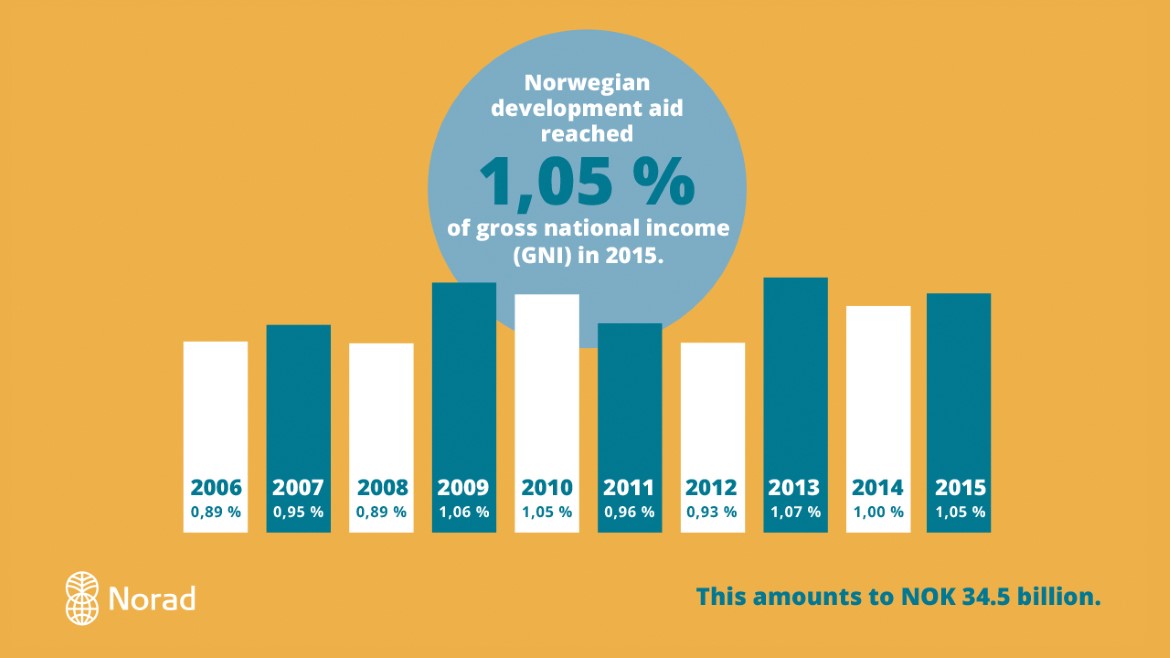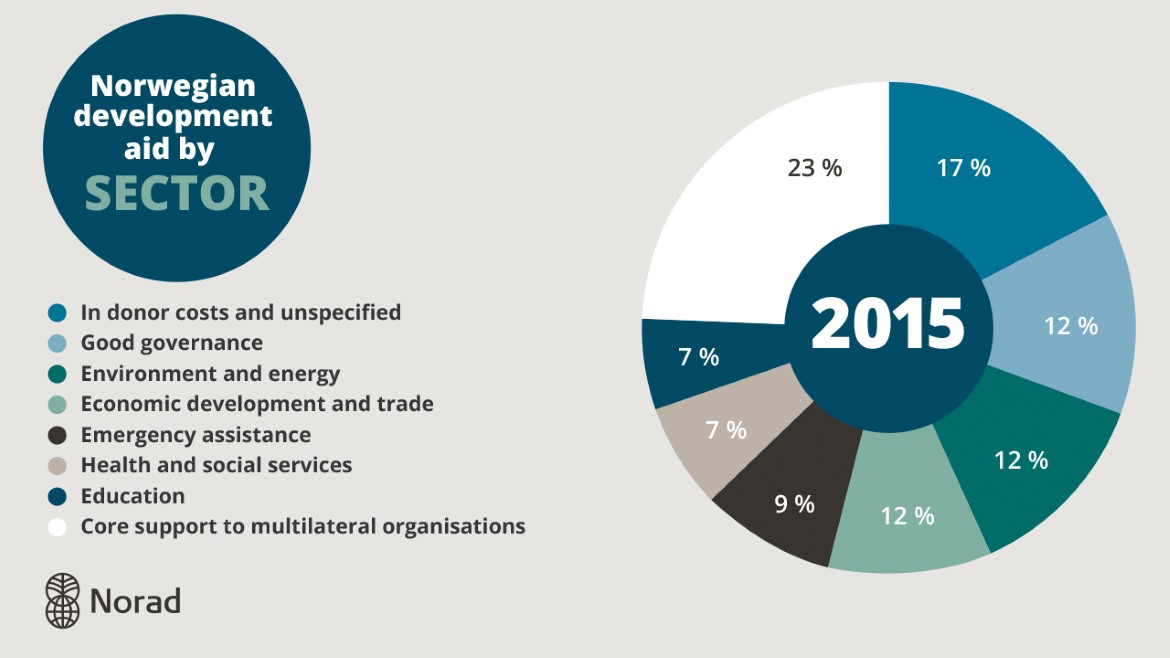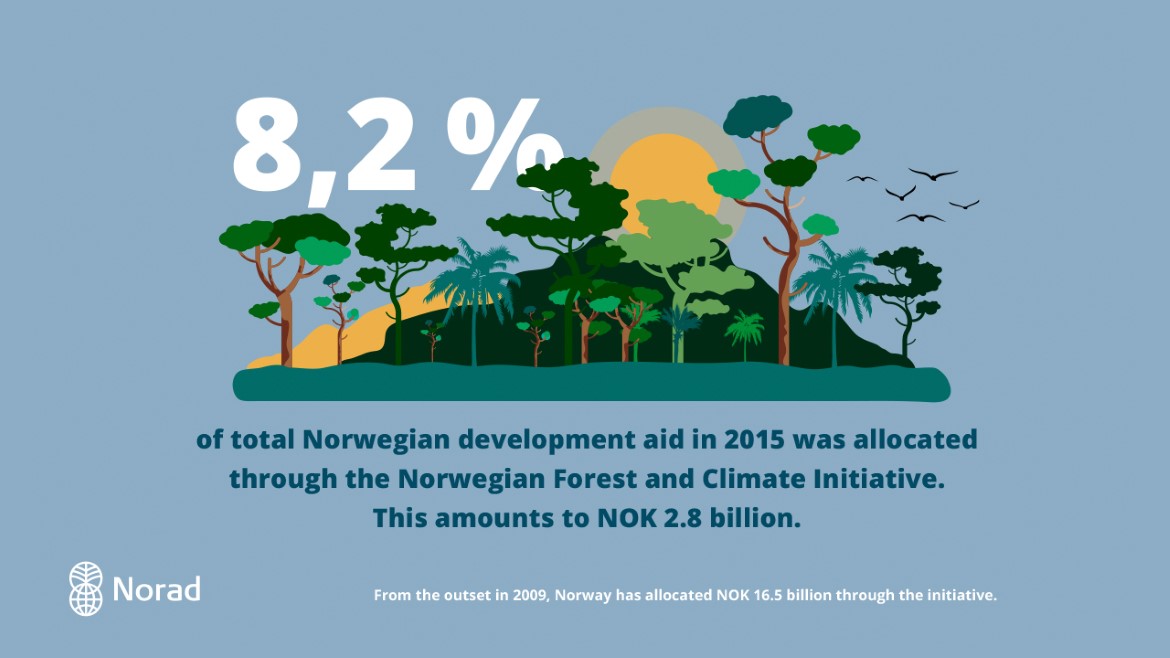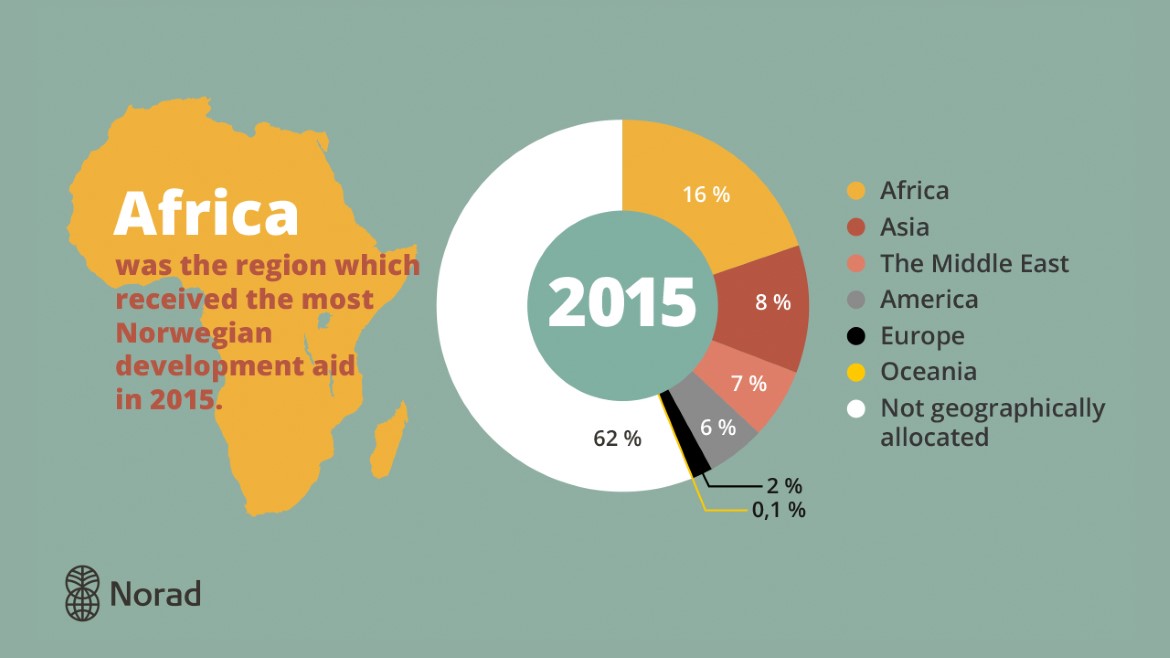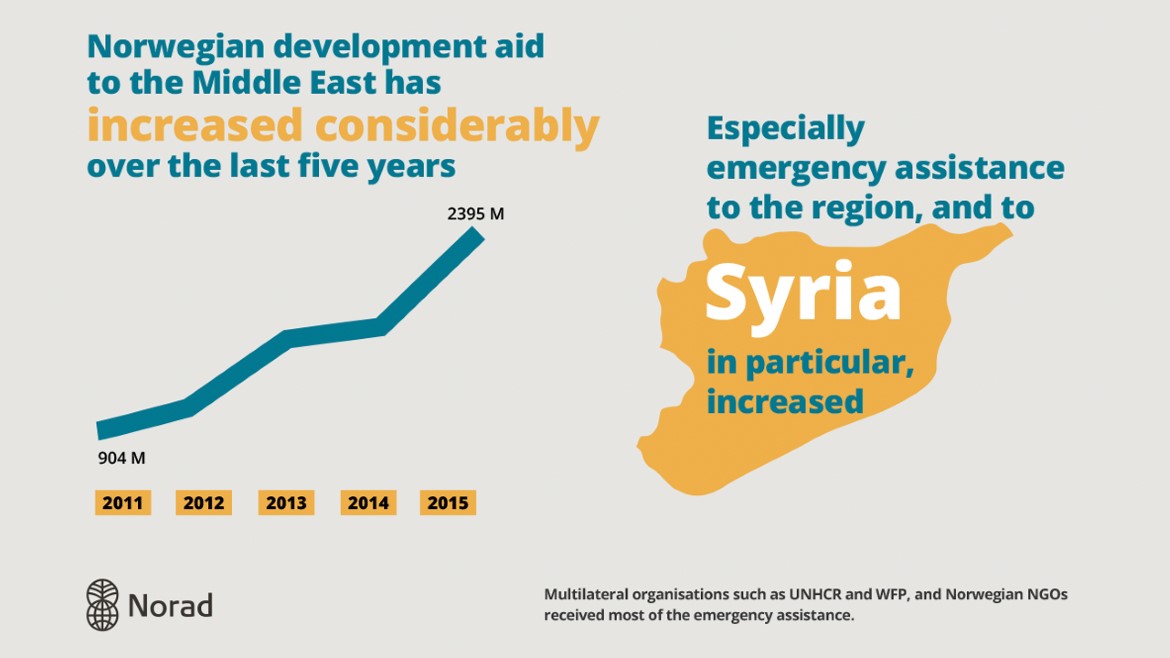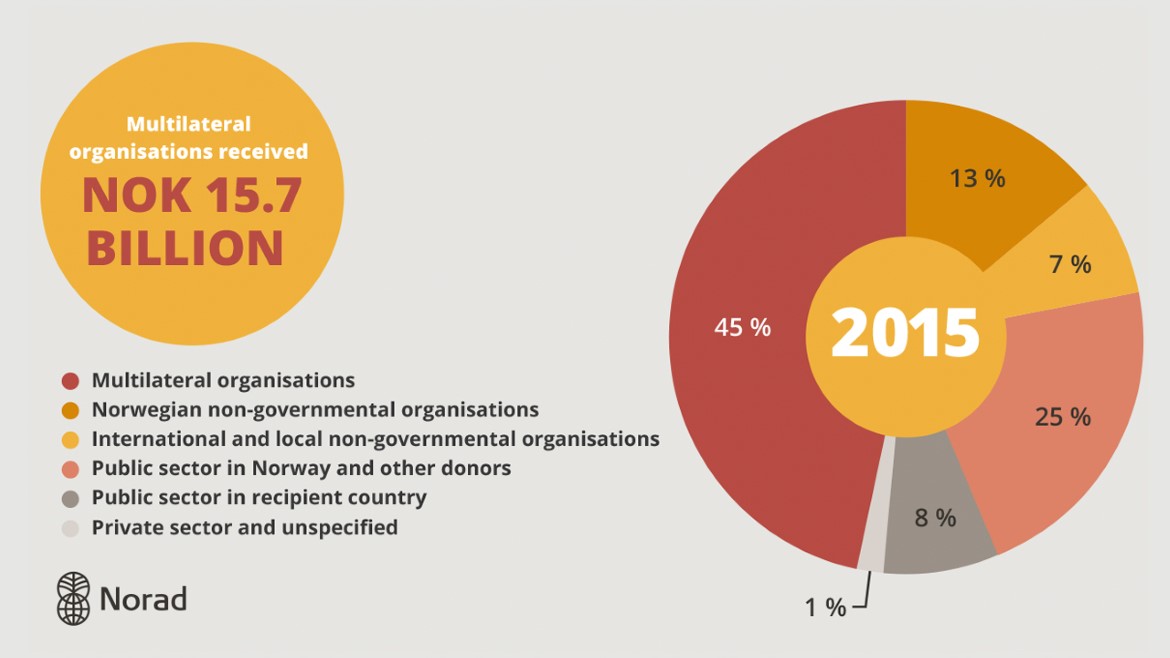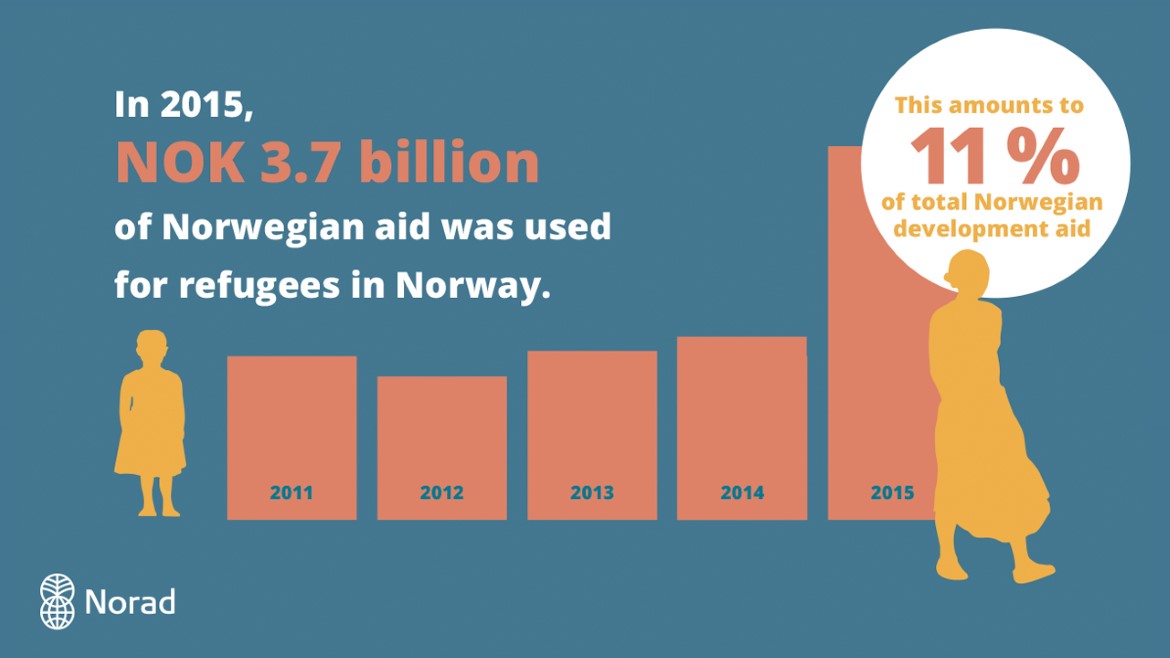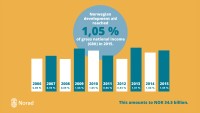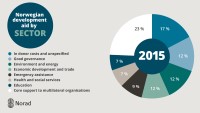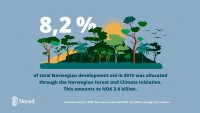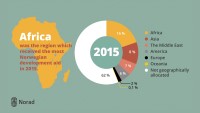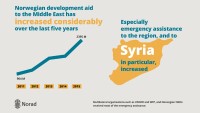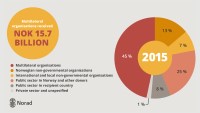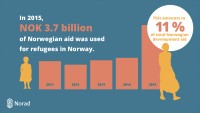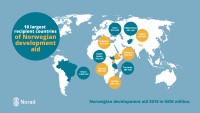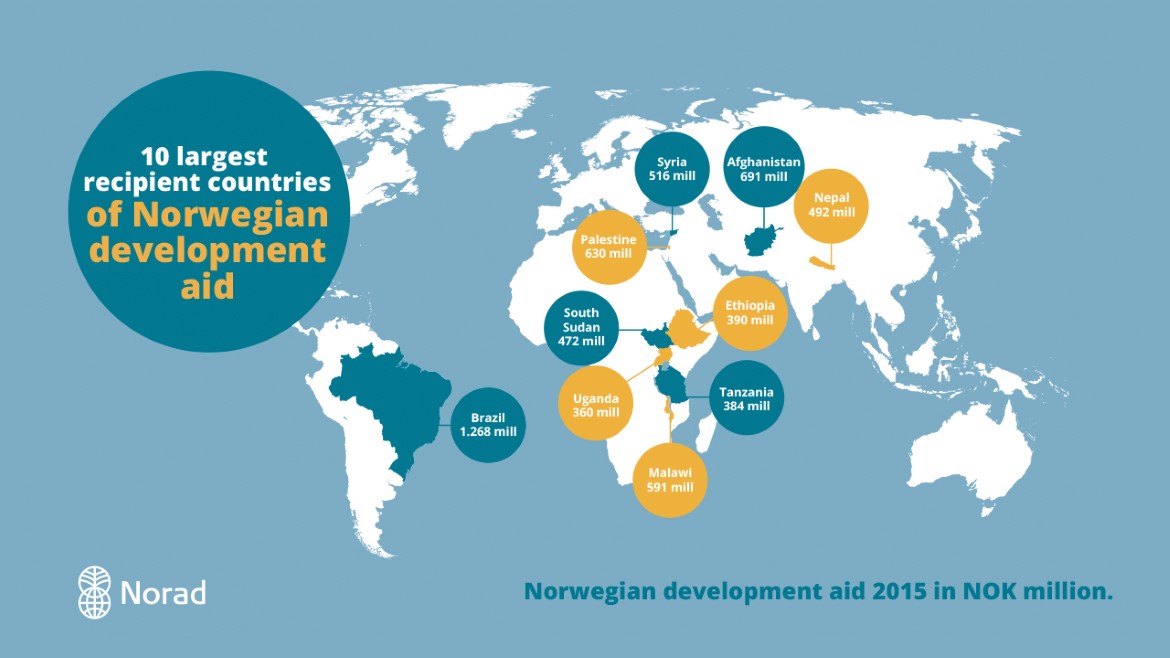
Norwegian development aid in 2015
In 2015, Norwegian development aid amounted to NOK 34.5 billion. This represents an increase of approximately NOK 2.4 billion on the previous year. Aid in 2015 corresponded to 1.05 per cent of Norway’s gross national income (GNI). In 2014, Norway gave NOK 32.1 billion in development aid, equivalent to one per cent of GNI.
Altogether 109 countries received Norwegian development aid in 2015, seven fewer than in 2014.
The figures have been retrieved from Norad’s statistics portal, on which the latest official figures are now available. Norwegian development aid statistics are in accordance with OECD’s Statistical Reporting Directives.
- Visit Norwegian Aid Statistics
Emergency assistance
In 2015, NOK 3.2 billion was spent on emergency assistance. This is equivalent to 9.3 per cent of total aid, and represents an increase of NOK 383 million on 2014. In addition to development aid classified as emergency assistance, aid is allocated to long-term efforts in humanitarian crises.
Altogether 42 per cent of Norwegian emergency assistance went to the Middle East, corresponding to NOK 1.4 billion. Of this, most went to interventions in Syria, a total of NOK 446 million. In addition, NOK 432 million went to regional interventions in the Middle East – mainly in the form of assistance to Syrian refugees. Emergency assistance to Jordan and Lebanon also increased as a result of the influx of refugees from Syria. Norway also provided NOK 179 million and NOK 123 million in emergency assistance to Iraq and Palestine, respectively.
The bulk of the emergency assistance to the Middle East was channelled through the UN High Commission for Refugees (UNHCR), the World Food Programme (WFP) and Norwegian non-governmental organisations, among them the Norwegian Red Cross and the Norwegian Refugee Council.
In 2015, Norway also gave a large amount of emergency assistance to South Sudan (NOK 207 million), Nepal (NOK 126 million) as a result of the earthquake in spring 2015, and Afghanistan (NOK 100 million).
In addition to NOK 3.2 billion for emergency aid interventions, NOK 462 million went in core funding to the UN Office for the Coordination of Humanitarian Affairs (OCHA) and the UN Central Emergency Response Fund (CERF).
Aid to refugees in Norway
One of the significant changes to the development aid budget from 2014 to 2015 was an increase in the expenditure on refugees in Norway. As a result of the influx of refugees to Europe and Norway, the number of Norwegian kroner in development aid that went to refugees in Norway increased from NOK 1.8 billion in 2014 to NOK 3.7 billion in 2015. This corresponds to 10.8 percent of the total development aid budget in 2015.
Development aid expenditure on refugees in Norway is administered by the Norwegian Ministry of Justice and Public Security, the Ministry of Children and Equality and, to a lesser degree, the Ministry of Education and Research.
The expenditure on refugees in Norway was also relatively high in 2009, when many refugees arrived. At that time, almost ten percent of the development aid budget went to refugees in Norway, corresponding to NOK 2.5 billion.
Brazil continued to receive most
Brazil received most Norwegian development aid in 2015, for the fourth year in a row. Following Brazil as the largest recipients were Afghanistan, Palestine, Malawi and Syria.
In 2015, altogether 97 per cent of all aid to Brazil was channelled through the Norwegian government’s International Climate and Forest Initiative which is administered by the Norwegian Ministry of Climate and Environment. A total of NOK 1.2 billion went to the Amazon Fund through the Brazilian Development Bank (BNDES).
Since start-up in 2009, Norway has given NOK 16.5 billion through the International Climate and Forest Initiative.
Increase in aid for basic education
Total direct aid for education amounted to NOK 2.5 billion in 2015. This represented an increase of NOK 664 million, or 37 per cent compared to 2014. Most of this increase was in the area of aid to basic education, which increased by NOK 560 million.
Malawi, Nepal and Lebanon were the largest recipients of aid for education. UNICEF and the Global Partnership for Education (GPE) were major partners in Norwegian aid for education in 2015.
Some reduction in aid to the poorest countries
Development aid to the poorest countries fell from 2014 to 2015. Last year, altogether NOK 11.6 billion went in aid to individual countries. Around half of these disbursements distributed by country, NOK 5.9 billion, went to the world’s least developed countries (LDC). This represented a small reduction of NOK 188 million, from 53 per cent in 2014 to 51 per cent in 2015. This is the continuation of a trend that has taken place over the last decade.
‘It is a matter of concern that development aid to the world’s poorest countries is falling. The world has committed itself to eliminating extreme poverty over the next 15 years. Today, many of the world’s poorest are living in middle-income countries; however, it is low-income countries which depend most on development aid in the fight to eradicate poverty,’ says Lomøy.
In its 2015 budget, the Norwegian Government launched a prioritisation of twelve focus countries where efforts were to be further strengthened. The focus countries were divided into two categories: one for ‘countries in development’ and one for ‘fragile states.’
Altogether 41 per cent of the development assistance to individual countries went to the government’s focus countries, an amount corresponding to NOK 4.7 billion. This is a small reduction from 2014, both in terms of Norwegian kroner (172 million) and as a proportion of development aid.
The development aid statistics for 2015 show a percentage increase of approximately seven per cent from NOK 2.2 to 2.4 billion for ‘countries in development’, namely Malawi, Nepal, Tanzania, Ethiopia, Mozambique and Myanmar. However, support to ‘fragile states’ fell by 12 per cent from NOK 2.7 to around NOK 2.3 billion in 2015. These countries are Afghanistan, Haiti, Mali, Palestine, Somalia and South Sudan.
More support through the UN, less through the World Bank Group
A total of 45 per cent of Norwegian development aid was channelled through multilateral organisations such as the UN and the World Bank. They received NOK 15.7 billion in 2015, which represents NOK 180 million less than in 2014.
There was an increase in aid to UN organisations of approximately NOK 1 billion from 2014 to 2015. The World Bank Group and regional development banks received less in 2015 than in the previous year. Among individual organisations, the United Nations Development Programme (UNDP) was the largest recipient with more than NOK 1.7 billion.
Norwegian non-governmental organisations received NOK 4.6 billion in 2015, approximately 170 million more than in the previous year. Altogether NOK 1.4 billion in aid to Norwegian organisations went to emergency assistance.

